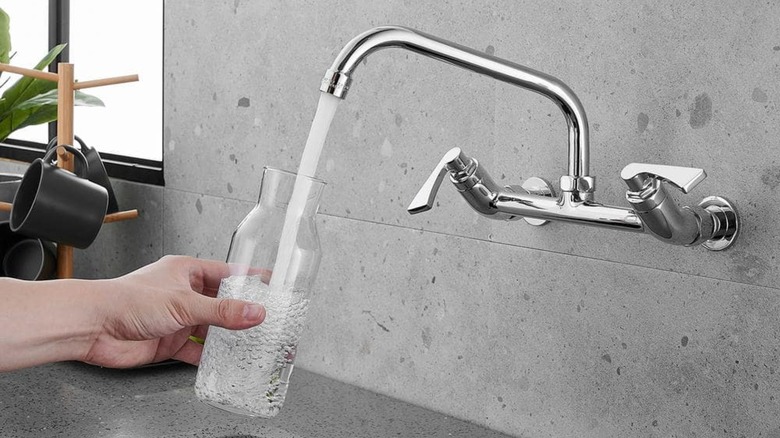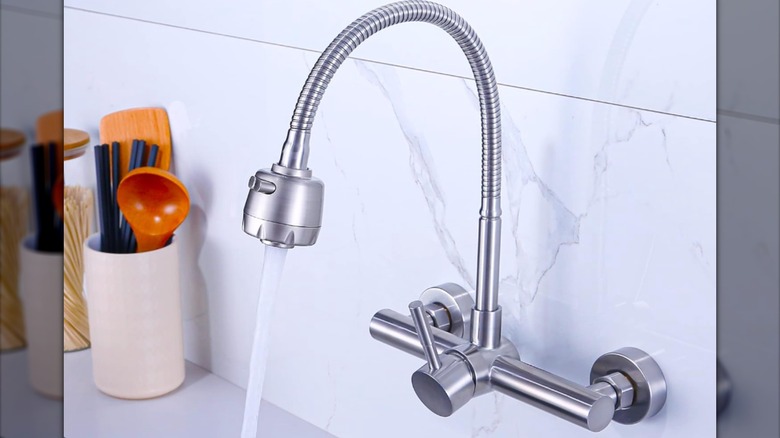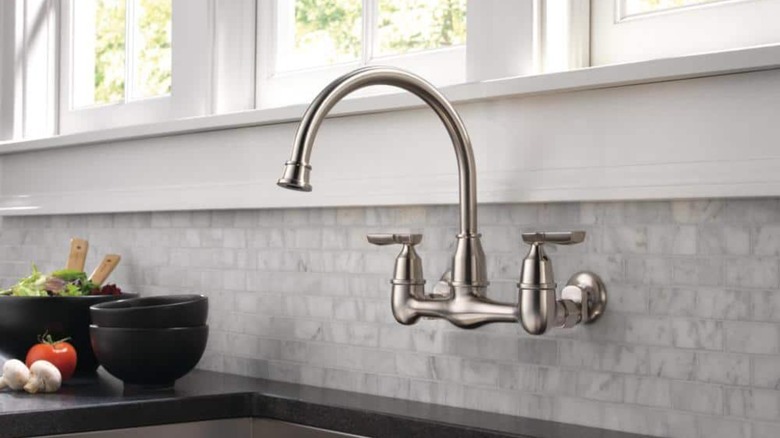The Pros And Cons Of Installing A Wall-Mounted Faucet In Your Kitchen
We may receive a commission on purchases made from links.
Your kitchen faucet can be the most eye-catching feature in the room. It sounds dramatic, but with trendy wall-mounted faucets, the conventional plumbing is also taking on an ornamental role. Unlike traditional deck-mounted taps which are installed on the countertop behind the sink, wall-mounted ones are installed on the wall, as the name suggests. Opting for these floating-style taps can be a great choice if you want something modern and distinct for your kitchen, but you should be privy to its pros and cons. While wall-mounted faucets are easy to clean and visually-appealing, they are difficult to install, can cause splashing, and are more expensive, especially if repairs are ever needed.
When it comes to choosing the perfect kitchen faucet for your sink, you want to consider cost, maintenance, design, and functionality. If you're willing to increase your remodeling budget for decorative plumbing, then you might be satisfied with the results. However, if practicality is your priority, you may be better off sticking with deck-mounted taps. It's best to know the ins and outs of wall-mounted faucets before installing one so your kitchen renovation doesn't become a nightmare.
Pros: sleek style and easy cleaning
Wall-mounted faucets are stunning. They have a high-end look that can give your kitchen a luxurious feel. Even if all the other hardware, like cabinet knobs and light fixtures, is simple, the floating tap can become a focal point that elevates your space. A wall-mounted faucet is also a great way to make the most of a small kitchen, as it doesn't take up any counter space, so you can choose a larger sink. Deck-mounted faucets require a wider area behind the sink to make room for the hardware. However, with wall-mounted taps, you can have a basin that covers the entire width of the countertop to maximize every inch of your small kitchen.
From a functionality standpoint, wall-mounted faucets can also be more hygienic than deck-mounted ones. Without the hardware in the way, you have better access to clean the backsplash and area behind the sink that can harbor hard water stains or food splatter. It is also easier to access all sides of the fixture, so you can thoroughly wipe the spout and handles without having to squeeze a cloth between the tap and the wall. However, the sleek style and cleaning-made-easy come at a high price.
Cons: tricky installation and expensive upkeep
A challenge with wall-mounted faucets is installation. These taps are typically mounted when the kitchen walls are under construction. If your walls are already completed, it will be difficult for a plumber to run water lines inside them. The tedious installation is expensive, too. While deck-mounted faucets average $120 to $300 for installation, wall-mounted ones average $200 to $600, and that's just for labor. And because of the trickier installation, this isn't a project you can simply DIY.
The placement of the faucet is also critical. If the spout is too high, it can be prone to splashing, and you often won't know if the height is ideal until the tap is already fitted. Adjusting the faucet can require more out-of-pocket expenses. Plus, if you already have a tile backsplash, it's possible the best place to mount the faucet won't be centered with the grout lines, making the hardware look oddly-positioned.
Another major concern with wall-mounted faucets is unnoticeable leaks. If the plumbing goes awry, the signs won't be visible until serious water damage has occurred. At this point, the wall around the sink will likely need to be replaced on top of the repairs to the pipes. While visually-appealing, wall-mounted faucets might not be a kitchen upgrade that is worth the price for those wanting a simple renovation.


